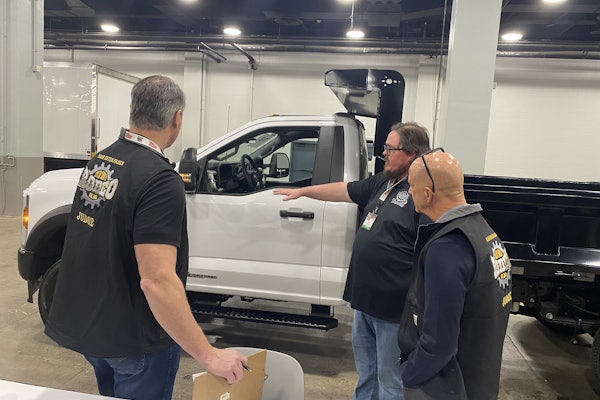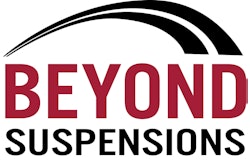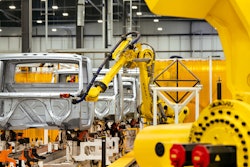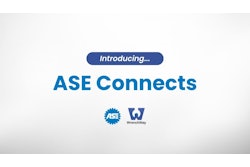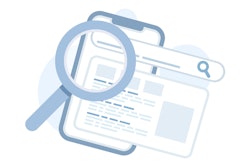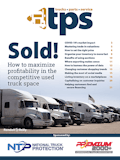Differential Pressure Sensor Hose & Clamp
The standard springs used on Mack CX, CH, CV, CL, RD, RB, DM, DMM, LE, MR, MRU and LEU model chassis (excluding CXN and CHN models) are designed to give the operator the smoothest ride possible. In achieving this, the chassis becomes susceptible to changes in weight that will affect chassis height and may result in chassis lean.
In most instances, chassis lean can be corrected by replacing the existing front spring spacer blocks with blocks of a different size.
The following guidelines will aid in correcting chassis lean:
- Check the chassis build records to determine the existing spring spacer block and spring part numbers.
- Before taking any measurements, ensure that the chassis is equipped with all customer-required accessories (such as PTOs, extra fuel tanks, tool boxes, etc.), and that all fuel tanks are filled with equal amounts of fuel.
- To ensure that the chassis lean is not a result of a weight difference between the left- and right-hand sides, weigh both sides of the chassis separately. If there is a significant difference in weight, the load must be redistributed before making any changes to the spring spacer blocks.
- With the chassis parked on a level surface, measure the frame height on both sides of the chassis at the front and at the rear as follows: At the rear, measure the frame height from the bottom of the frame flange to the floor. If the chassis is equipped with a Reyco suspension, ensure that the spring seats are the same on both the left- and right-hand sides. If the chassis is equipped with an AL suspension, ensure that the chassis is set to the correct ride height and that all main beam members are contacting the wear surface of the spring hanger.
Note: If the main beam members are not contacting the wear surfaces of the spring hangers on chassis equipped with an AL suspension, loosen and re-torque the spring clips.
At the front, measure the frame height from the bottom of the frame flange to the floor. Take this measurement from behind the front bumper.
A / inch or less difference in frame height between the left- and right-hand sides of the chassis is acceptable. A difference greater than / inch indicates the need to replace the existing spring spacer blocks.
Chassis are built with both equal and unequal spring spacer blocks. When correcting chassis lean, select the appropriate spacer. Use a spacer with the smallest dimension necessary to correct the lean.
For reference, spacer Part No. 13QK244AP9 is 2 inches; Part No. 13QK244AP21 is 2.10 inches; Part No. 13QK244AP24 is 1.69 inches; and Part No. 13QK244AP25 is 1.81 inches.
When correcting a chassis lean, always make changes on the right-hand side of the chassis first, then check to determine if the lean is corrected. Changing the left-front spring spacer can affect steering geometry and may cause additional problems. If changing the right-hand spacer cannot correct the lean then replace the left-hand spacer.
After adjusting the chassis to an acceptable height, it may be necessary to adjust the front bumper to compensate for any changes. A /-inch difference at the frame can result in a 3/4-inch to 1/-inch difference at the extreme top outside edge of the bumper.
Note: Under rated load, the spring may appear flat or slightly negative arched. Also, you may notice a gap between the spring blades. These are design characteristics of the springs, not an indication of a weak spring, and are not a reason for replacement. Replacing the springs will have no effect on chassis lean.
Filter Cover Bolt Hole Repair Kit
To facilitate the repair of the filter cover bolt threads in the main case on all Allison 3000 and 4000 transmissions, the company has released a filter cover bolt hole repair kit, J-42385-ALT. The kit can be used for thread repair with any 3000 or 4000 product family model.
The kit allows you to replace the threads in or out of the chassis. It uses a solid, thin-walled, self-locking steel bushing insert to repair the filter cover bolt threads in the main housing of the transmission. The thread inserts repair the filter cover bolt threads to their original specification.
The kit contains:
- Template J-42385-230 (main filter)
- Template J-42385-234 (lube filter)
- Two alignment pins, J-42385-308
- M10 step drill, J-42385-2321
- Tap, J-42385-232
- 60 inserts, J-42385-514 (the kit contains six packets of 10 M10 X 1.5 x 24.5)
- Insert driver, J-42385-233
- Tap wrench, Part No. 5110260
- Six M10 retaining bolts, Part No. 206158
- Driver oil, J-42385-110
Prior to beginning the field modification procedure, the filter cover bolt holes must be inspected to assure the M10 step drill can properly prepare the hole for thread cutting with the tap. If any of the filter cover bolt holes are oversized, the transmission main housing must be replaced.
Note: The Allison factory installed steel inserts use the same hole and thread size as the Thread Repair Kit inserts, however the M10 step drill must be used to counter-sink the hole before the Thread Repair Kit inserts are installed.
Electrical Equipment Panel Label
On Mack MRU models, the electrical equipment panel label (located on the underside of the electrical center access panel), may present some confusion as to how to illustrate the location of the relays and fuses on the actual panel.
Figure 1 shows the label as it appears on the access panel, and the electrical equipment panel as it is seen when seated in the passenger’s seat.
To avoid confusion, use the 30 amp HVAC circuit breaker as a reference point when performing any type of service involving the electrical equipment panel.
Always be aware of the correct fuse/circuit breaker locations. When reprogramming an electronic control unit, failure to remove the correct fuses can fatally damage the ECU.
Safety Recalls
The National Highway Traffic Safety Administration (NHTSA) has issued the following recalls:
- The extension pipes attached to the aftertreatment regeneration device (ARD) on certain Crane Carrier vehicles equipped with Caterpillar C13 diesel engines may develop a hole. This could cause heat and flames to escape during the regeneration of the diesel particulate filter, which may result in a fire hazard.
- One hundred eighty-one 2007 to 2008 model year Autocar WXLL heavy-duty Class 8 trucks equipped with residential front-loader applications may develop cracks in the top flange of the RH extension of the frame rail at the front splay break where the reinforcing straps are welded. During front-loader operation, residual hydraulic pressure causes the front loader system to push down on the bumper-mounted brackets, causing a visible deflection of the chassis from the suspension front hanger bracket forward. The deflection eventually may result in cracking of the frame rail.
- During the manufacturing process on 1,195 2007 to 2009 model year Hino NV8J trucks, the propeller shaft bolts may not have been tightened properly. If the bolts were to loosen, it could cause a vibration in the driveline. If this vibration is ignored, the propeller shaft could separate from the mating flange. This could result in damage to property or result in a crash.
- The fuel pump outlet check plug on 16 2007 to 2008 model year Crane Carrier LDT2 and LET2 refuse packer vehicles equipped with Caterpillar C7 or C9 diesel engines, may be cracked, which could cause fuel to spray and leak. Fuel leakage in the presence of an ignition source could result in a fire. This situation also applies to 263 2008 to 2009 model year Kenworth T800s, W900s and Peterbilt 365 and 384 trucks with Caterpillar C7 and C9 diesel engines.
- As a result of various alternator cable routing configurations on 175 2004 to 2008 model year Daimler Trucks Orion V and VII buses equipped with Cummins ISL diesel engines, it may be possible for the cable to rub on engine components. When the cable rubbing is not detected during regular maintenance inspections, the insulation can rub to expose the electrified cable. Arcing can cause a fire.
- An increase in lateral and vertical axle movement may occur on certain Kenworth trucks built with an AG400 rear suspension, long stroke brake chambers and wide-base tires. This movement may cause part or parts of the brake assembly (brake cam tube support, brake chamber bracket, brake chamber, brake spider) to develop fatigue cracks, possibly resulting in the failure of the parts within the brake assembly. A failure may reduce brake performance, increasing the risk of a crash.
- Inadequate stiffness of the diesel particulate bracket on 3,640 2006 to 2009 model year Kenworth T600, T660, T800, W900, T2000 and 2008 to 2009 model year Peterbilt 365, 367, 379, 384, 386, 387, 388 and 389 trucks, could result in separation of the DPF from the chassis. A vehicle crash could occur if another vehicle strikes the DPF on the roadway.



